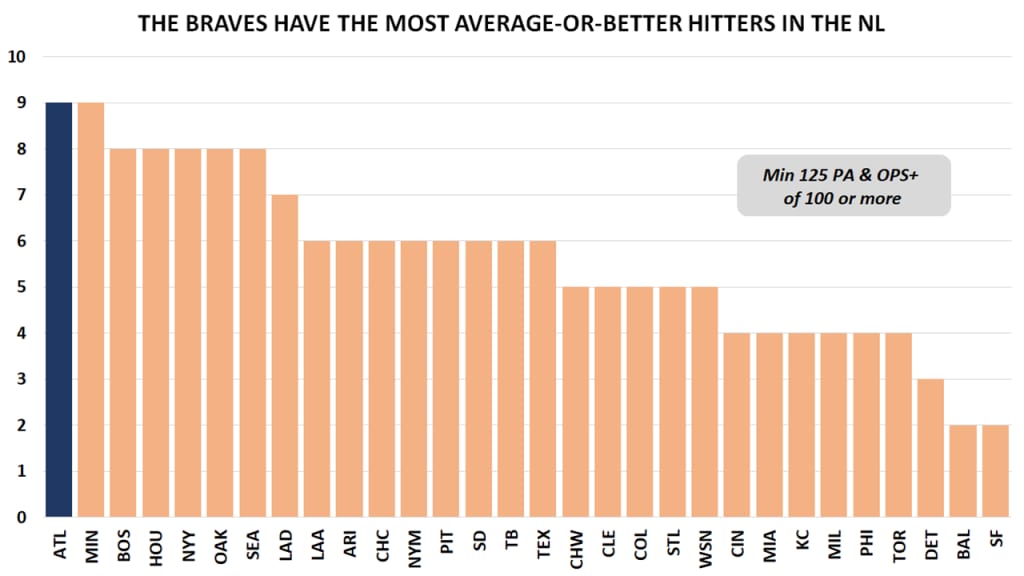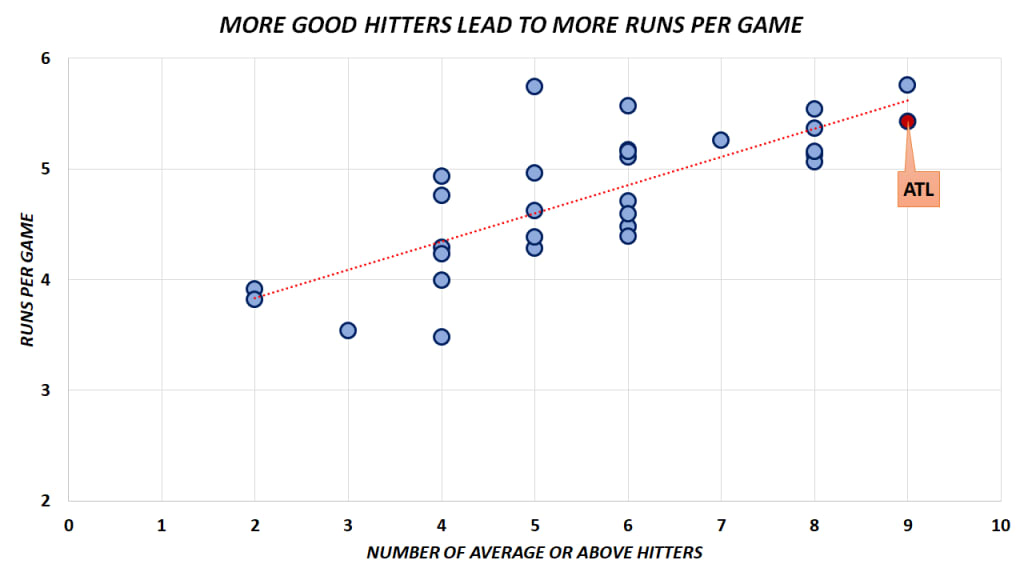The 44-32 Braves are pulling away in the National League East, and while that may be partially because the Nationals and Mets can't get out of their own way -- and because the second-place Phillies have lost five straight and seven of eight -- it's mostly about their lineup. Atlanta's offense is good, and it's deep. It might be the deepest in the National League.
That's different than "having superstars," though the Braves certainly do have that in Freddie Freeman and Ronald Acuña Jr. (And, depending on how you expand the term, in Josh Donaldson, a former MVP who is now "merely" an above-average hitter, and rookie sensation Austin Riley, who is pounding the ball despite the second-highest swinging strike rate in baseball.)
The Rockies, for example, have a few superstars in Nolan Arenado, Charlie Blackmon and Trevor Story, but their lineup isn't deep. It has holes. Say the same for the Mets -- Pete Alonso and Michael Conforto are studs, but there's a ton of weakness otherwise -- and most other NL teams, even the Dodgers, who haven't received much from catcher or second base.
But the Braves, who have the second-most runs in the NL along with the second-best on-base percentage and the second-best OPS, have something else. Among the 11 Atlanta hitters with at least 125 plate appearances, an NL-leading nine were average or better, in terms of having a 100 OPS+ or higher, entering Friday's game.

You can see the strength here up and down the lineup. (Stats entering Saturday.)
153 OPS+ // Freeman
140 OPS+ // Riley
121 OPS+ // Acuña
120 OPS+ // Donaldson
115 OPS+ // McCann
105 OPS+ // Albies
104 OPS+ // Flowers
100 OPS+ // Markakis
99 OPS+ // Swanson
64 OPS + // Camargo
61 OPS+ // Inciarte
It's not perfect all the way through, obviously. Ender Inciarte disappointed before he injured his back, and Johan Camargo has taken a huge step back from his successful 2018. Nick Markakis and Dansby Swanson straddle the 100 OPS+ line daily, though a few points here and there don't really matter. But -- and we shouldn't need to say this, yet it feels like we ought to anyway -- "having a lot of good hitters" correlates very well with "scoring a lot of runs per game."

This should be unsurprising, because this kind of depth makes for no easy outs. (Camargo is a backup, and Inciarte probably has lost his job with Riley's move to the outfield.) That's something the Cubs can't say with their second basemen hitting just .208/.285/.345, and it's something the Dodgers can't say with their catchers hitting only .247/.340/.393.
It's not to say that these are all superstar hitters, because they're not. Markakis is the same unspectacular, competent veteran bat he's been for a decade now. Swanson perpetually seems on the edge of a breakout that just hasn't fully happened yet. Brian McCann, now 35, hasn't completed a full season hitting like this since the end of his first stint in Atlanta back in 2013.
But what the lack of easy outs does do is help the Braves avoid the somewhat hit-or-miss -- no pun intended -- nature of teams with a more stars-and-scrubs setup. You can see that in numbers like ...
• No team has had fewer games scoring one or zero runs (five; Miami has 27)
• No team has had fewer games with 10 or fewer total bases (15; Miami has 41)
• Only one team (Cubs) has fewer games with 5 or fewer hits (8; Toronto has 25)
... and you get the point. It's not that the Braves are the best at anything in particular -- they're sixth in the Majors in hard-hit rate, eighth in strikeout rate, tied for 11th in walk rate, and with the ninth-lowest ground-ball rate -- as it is that they're not really poor in much of anything, either. It's a little hard to run into a stretch where no one is hitting when you've always got a few guys who are capable, of, you know, hitting.
Under the radar, more advanced metrics do paint the Braves more favorably. They hit the ball at the "right" launch angles, between 8 and 32 degrees, what we've termed "the sweet spot," the third-most often in baseball, which helps explain their low ground-ball rate and the fact that they've hit the third-fewest popups in the game. It also helps understand how the Braves have the second-most barrels, the perfect combination of exit velocity and launch angle, the most valuable batted balls you can find.
None of that is an accident, for what it's worth. Braves hitting coach Kevin Seitzer preaches it.
If the Braves can finish the season with nine average-or-better hitters, which is easier said than done, it would be tied for the second-deepest Braves lineup since the team moved to Atlanta in 1966. If part-time players Charlie Culberson or Matt Joyce collect enough plate appearances while still hitting well, or if a trade acquisition or Minor League callup (maybe Adam Duvall, slugging .566 in Triple-A) manages to join that group as well, then 10 above-average hitters would tie the 2009-10 teams of McCann, Chipper Jones, Martin Prado, Omar Infante and friends.
But: how likely is that? We can't tell the future, obviously. What we can do is to look at some tools to see which Braves we might expect to keep this up, or not.
One way is to look at Statcast expected metrics, to try to get past "good or bad luck" and into performance to date. These aren't predictions or projections, but the idea is that there's value in knowing if someone is hitting .350 because they've been pounding the ball or because they've been very fortunate in not finding gloves.
The way we'll do that is to compare their actual Weighted On-Base Average (wOBA) -- an OBP-like measure where extra-base hits are given more weight, and where the Major League average is .324 -- with their Expected Weighted On-Base Average (xwOBA), which attempts to strip out the effects of defense and luck to look at quality of contact and amount of contact. (That is: Donaldson deserves credit for ripping this ball to left, even though he got an 0-for-1 on it because the left fielder committed an error.)
As you'd perhaps expect, we have names on either side of the line.

Riley, Freeman, Inciarte, and Donaldson have all more or less "earned" what they've put up so far. It's not a guarantee that they'll continue to do so, but they haven't been helped or hurt by good luck or bad defense or anything like it. That's great news if you like watching Riley and Freeman mash; it's less great if you're concerned about what Inciarte can offer, especially since 2018 was his weakest hitting season in Atlanta to begin with.
You can find some interesting stories here. You might have expected slightly more from Swanson, Acuña, Markakis and Ozzie Albies. Tyler Flowers and McCann may be getting more than they've earned, which makes sense, though that also being true for Camargo isn't a great sign.
“We’re swinging the bats,” Donaldson said to MLB.com earlier this week. “I don’t know how much better it can get than what it is right now. We’ll see how long it rides.”
We don't know what's going to happen, of course. What we do know is that the Braves look like they're the only stable team in the NL East right now, and they managed to add Dallas Keuchel to a talented-but-inconsistent rotation. But if they do hang on to win this division, it's going to largely be about the offense. It's not the best or most talented. It might be the deepest. That matters, too.
